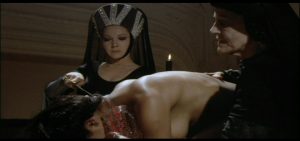Conclusion
A legendary film with a cult following, also known as El Retorno de Walpurgis or 'the Return of the Walpurgis'. You can't really go wrong when your blood looks like molten crayons and your werewolf costume looks like one of the Berenstain Bears.
Actually, you can go very, very wrong when your werewolf costume looks that Semitic. Not that there is anything wrong with looking Semitic, just that it doesn't exactly conjure up images of a savage half man, half beast creature. I'm talking Ashkenazi Jews here.

Fair is foul and foul is fair. May every Daninsky be covered with hair.
This movie is entertaining because the translation leaves much to be desired and the blood looks like molten crayons and the werewolf costume looks like the Berenstain Bears. Pyjamas and all.
Plot
Waldemar Daninsky (Paul Naschy) accidentally kills a werewolf, thereby fulfilling an ancient prophecy. This prophecy holds that one of the Daninsky family would accidentally kill one of the Bathory family. My karma ran over your dogma who happens to be a werewolf.
The murder sets a curse that the Bathory family placed upon the Daninsky family in motion. The Daninsky curse in general falls onto Waldemar Daninsky in particular. The Bathory family were burnt at the stake by the Daninsky family on Walpurgis night, and from there the return of the Walpurgis in the title.

Exhibit A: Spot the difference between the Berenstain Bears and Waldemar Daninsky (this is Waldemar Daninsky).

Exhibit B: Spot the difference between the Berenstain Bears and Waldemar Daninsky (this is the Berenstain Bears). Taken from Pbase.com
During the film, Waldemar adds nearly as many notches to his bedpost as the average James Bond does, but with far more fleas.
Review
- Paul Naschy holds the record for playing the Berenstain Bear, er I mean wolf man the most number of times.
- In the first half hour, you have duelling knights, a black mass, a public execution by hanging, an occult curse by one Bathory and a burning at the stake. Somehow, this film does not manage to steer clear of the cheese after that either.
- In all fairness, this film is not bad at all. The acting and the set design are both great, and the plot gives a nod to ancient European superstitions. It is made with much passion, but it did not age that well and it is unintentionally hilarious at points.
- At the time, Paul Naschy had problems with the authorities regarding the religious, sexual and violent content of his wolf man films. This is hard to believe - almost as hard as believing that the actors managed to keep straight faces through all the molten crayon blood. The times they are a changing indeed.
There is however one aspect of Curse of the Devil that still applies to our times. This is of course the mass hysteria of the pitchfork wielding peasants. Despite some authors like James Surowiecki arguing that crowd wisdom is superior to individual wisdom, it is clear that as much as crowd participation compounds success, it also compounds dismal failure. In his book, The Wisdom of Crowds, Surowiecki identifies four elements required for a wise crowd:
Four Elements Required for a Wise Crowd
- Diversity of opinion, whereby each person should be privy to his own viewpoint, no matter how eccentric.
- Independence, which determines that each individual is allowed to formulate his own opinion without fear of favour or prejudice or death threats.
- Decentralisation, making provision for localised and/or specialised knowledge, like say the knowledge inherent in the separation of powers principle.
- Aggregation, which is a mechanism for orchestrating the various judgements into a cohesive decision. An example of such a mechanism is Dotmocracy.
It is clear that the pitchfork wielding peasants were not allowed a diversity of opinion, I mean either Wandinsky is the wolf man and deserves to be killed or... no, that's the only option really. They were thus not free to disagree with the mob leader either. Similarly, they did not allow for localised or specialised knowledge, since the investigator sent by the authorities was ultimately not allowed to give his input. Even after he allowed them to pursue their own ways of dealing with Wandinsky, they killed the investigator. There is also a noted absence of aggregation. The mob merely goes from one mob leader to the next, ironically much like a pack of wild dogs choosing its leader by virtue of him being the strongest. As usual, truth is stranger than fiction. Fiction has to make sense, as the famous quote goes.

Exhibit C: Spot the difference between a real mob and a fictitious mob (this is a fictitious mob exhibiting compound failure).

Exhibit D: Spot the difference between a real mob and a fictitious mob (this is a real mob exhibiting compound failure).
Note the similarities between the real mob and the fictitious mob. The one has made up its mind about who is guilty, who is innocent and no matter what the reality is, they already decided to kill those who oppose them. On the other hand, we have the pitchfork wielding peasants who run after Wandinsky in the Curse of the Devil.
For those outside South Africa who might still be in the dark, try this erudite legal opinion on the ANCYL leader Mamela's threat to kill those who oppose Jacob Zuma.
Director
Carlos Aured.
Cast
Fabiola Falcón, Anna Farra, Jacinto Molina, aka Paul Naschy, Inés Morales, Martiza Olivares.
Rating



2 comments:
I love the site, man. Very enter-fuckin'-taining. Nice movie review, too. I have a feeling I may I have to watch this movie under some chemical influence. :)
Heyy, thanks for posting this. I digg your site and thanks for all of the information.
I bookmarked your blog! :)
Take care!
Post a Comment